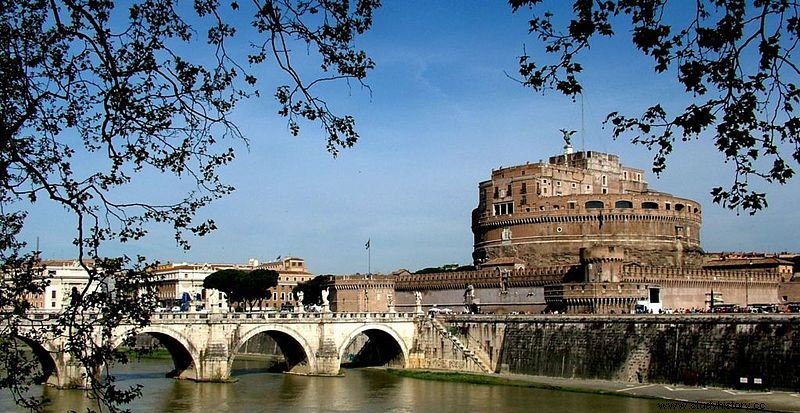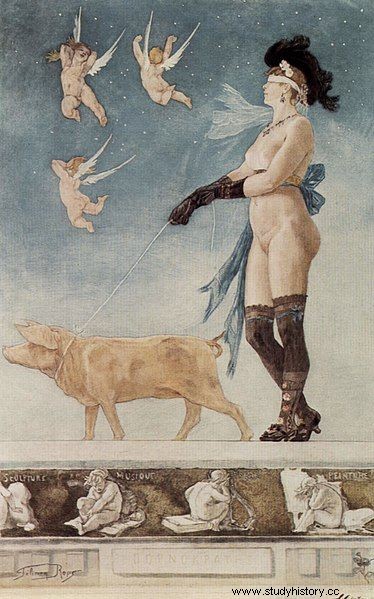These are times that the Catholic Church would prefer to erase from the pages of history. Never before or after have morals and moral standards in the See of Peter have fallen so low. Instead of chastity and restraint, successive popes adhered to mammon, lusts for luxury and power, and debauchery. It is hardly surprising that the 10th century C.E. in the history of the Vatican it has been called ... pornocracy.
The period in question began with the pontificate of Pope Sergius III in 904. In those days, the same brutal games were fought around the throne of Peter as in the case of the competition for royal or imperial power. Popes changed frequently, many did not die a natural death. In place of those dropped from the throne, their political opponents, the so-called antipope.
Corpse to court
Does it have much to do with Christ's forgiveness of sins? That's right! Sometimes the fierce struggle for power in the Vatican took on macabre, even grotesque dimensions. This was the case during the so-called the corpse synod of 897, when, 9 months after the burial, the body of Pope Formosus was removed from the tomb - to dress them in pontifical vestments, sit on the throne of Peter, and then, as part of a staged trial, deprive them of dignity and respect.

"Deadly Synod", or the posthumous judgment on Pope Formosus
The body of the posthumously dethroned holy father was dismembered and thrown into the Tiber. All this - apart from the symbolic one - also had a political meaning. The dethronement of the pope at the same time invalidated all his decisions, including personal ones - concerning the successor and the clergy at lower levels.
Who was distributing the cards in the game of the Vatican coterie at the time? At the beginning of the 10th century, decisions about who would rule the See of Peter were made behind the scenes by the family of Roman patricians - Tusculum. Due to their sexual and family connections, the Vatican has turned into a brothel…
The figure of Theophylact, the senator in command of the Vatican army and in charge of its finances, comes to the fore here. He was a gray eminence, but the spouse of Theophylact - a certain Theodora - had an even greater influence on the "staffing" decisions. It was she who elevated to the highest papal dignities the young Count Sergius, who was her lover (and her husband's cousin, by the way).

Boniface VI, after two weeks in office, died of gout, although another version says that he was poisoned.
The vacancy on Peter's throne came after Pope Stephen VI (the one who called the Synod of the Dead to deprive Formosus of honor) left this world as a result of suffocation, and his successor, Boniface VI, died of gout after two weeks in office - though another version says he was poisoned.
It was then that the enterprising Teodora decided to promote her lover. Theophylactus must have known about his wife's unfaithfulness, but that apparently did not matter much to him. The betrayals were a small price to pay for the fact that the head of the church could be influenced through connections, thereby ruling the Vatican from the back seat.
For the sake of accuracy, it should be noted that at that time Catholic clergy were not yet required to remain celibate. It became mandatory only after Pope Gregory VII's reforms in the 11th century . Previously, priests could voluntarily decide to live without marriage and sexual restraint - such an attitude was appreciated. Of course, even though there was no formal requirement, all believers, and especially those belonging to the clergy, should have avoided fornication. Somehow, this was not remembered in the 10th century in the Vatican…
Everything stays in the family
Sergius III ruled in the See of Peter for 7 years, which was an exceptionally long period for those conditions. What's more - despite the fact that he quickly got bored with his mistress, he died a natural death. Before his departure from this world, Theodora decided to bind Peter's throne with the family of Tusculum forever. To this end, she offered the Pope her young, only 15-year-old daughter Marosia.
Sergius III decided it would be a sin not to take advantage of the young charms and soon ended up in bed with Marosia. A related couple had a son - Alessandro, who 20 years later ... became pope.
While the former lover was pleasing her daughter, Theodora chose another chosen one, Father John of Tossignano. The young clergyman, with the help of an influential matron, quickly climbed the career ladder. He became Bishop of Bologna, then Archbishop of Ravenna. Metresa even prepared him for a new pope, but the death of Sergius III thwarted her.
Popes to be replaced
John was not yet firmly established in the Roman elite to be seated on the throne of Peter - and this one could not, after all, remain empty. Therefore Theodora and her husband quickly found a "provisional" pope . It was Anastazy III, who headed the church for only 2 years (of course, only formally). Historians have no doubts that the real rule was instead of a figurehead consul Theophylact and his dissolute spouse.

Theodora decided to bind Peter's throne with the Tusculum family forever. To this end, she offered the Pope her young, only 15-year-old daughter Marosia.
Anastazy died suddenly, officially after he had suffered from indigestion. He was replaced by Pope Lando, who, however, also did not enjoy his function for a long time. After 7 months he had an unfortunate accident. He accidentally fell into the Tiber…
There was a vacancy again. This time, however, Theodora's favorite was ready to fill it. In March 914 he became pope as John X. He ruled for a long time, until 928, but a terrible fate awaited him. Three years after he took the bishopric of Rome, his lover and patron died. And with Marosia, her elder daughter, the Holy Father did not have a good relationship.
He was too independent. He couldn't be steered. He had political ambitions and a strong character. Barely a year after taking power in the Vatican, he personally fought against the Saracens on the battlefield. Christian forces then crushed the enemy at Garigliano in southern Italy. After this victory, the Pope anointed the Italian king Berengar as emperor.
All this did not please Marosia. When John X turned into feathers too much and tried to become independent from the Tusculum family, first robbers sent in front of him stabbed his brother, then he himself was imprisoned by Marosia and her husband. He died treacherously - he was strangled in his cell in the Castle of St. Angel in Rome.
Bastard-Pope
The removal of John X was to pave the way for the papacy of Marosia's son from her affair with the previous holy father, Sergius III (who also slept with her mother). However, John XI was too young to lead the Church, so there were again some "provisional popes." It is about Leo VI, who ruled only a few months in 928 and was murdered. A similar fate awaited his successor, Stefan II.
Finally, the son of the Pope and concubine had grown up enough to follow in his father's footsteps. This fact, even by contemporary standards, was scandalous to the Roman people and officials. Marosia, though influential, had a reputation for being a woman of light manners. Everyone also knew her son was a bastard.

St. Angel in Rome, place of death of many popes from the 10th century AD (present view)
But John XI ruled for four years anyway. His stepbrother, Alberyk, overthrew him. Disappointed by the favoritism of John's mother and Marosia's marriage to a certain Hugh (king of Italy), he sparked a revolt in Rome. The crowd of residents stormed the mansion of a dissolute matron. Marosia ended up in a dungeon, and John was also imprisoned, for which Alberyk proclaimed himself the prince of Rome. It was probably he who passed the sentence on his mother. Thus, Marosia of the Tusculum family was murdered at the behest of her own son.
From then on, it was Alberyk who dealt cards in the Eternal City and it was up to him who would sit on the papal throne. He chose pious and obedient elders. It seemed that the institution of the papacy had thus regained at least a substitute for dignity, but nothing could be more wrong. Alberyk prepared the throne of Peter for his son Octavian. The worst for the Vatican was yet to come ...
Devotee of Satan on the throne of Peter
In 955, at the age of only 18, Octavian, son of Alberyk, became pope and took the name John XII. The highest position in the church was taken by an irresponsible, uncouth young man with an unbridled temperament and an unbridled sexual appetite for representatives of both sexes. During his time, the papacy must have fallen at its lowest level in history.
The researchers of this pontificate say straightforwardly:John XII, the youngest pope in history, turned the Vatican and the Lateran Palace into a brothel. He organized orgies with prostitutes, whom he paid for services with chalices and other liturgical accessories. He raped nuns and distributed dignities and church positions as a joke to his colleagues. He once ordained a 10-year-old boy for fun. During John's pontificate, the wine poured in streams during binge drinking. The Pope and his friends "punched" cards and paid off debts with church property.

Artistic vision of pornocracy according to the Belgian painter Félicien Rops
But that wasn't the worst of it. According to historians' research, the Holy Father… detested Christianity. He repeatedly mocked his faith, committed profanation and blasphemy. He ordained bishops in the horse stables and publicly toasts to Satan during an orgy.
The news of his excesses finally reached the ears of Emperor Otto I. In 963, he, along with the armed men, came from Germany to Rome and deposed John from office. He then called a synod of bishops who found the former pope guilty of fornication, simony (trading in church offices), perjury, incest and murder.
The dethroned Holy Father after Otto's departure still tried to regain power. He even managed it - but only for a short time. He also sparked a bloody suppressed rebellion. He died shortly after - reportedly of a heart attack, but according to an alternative theory suffered a stroke during a sexual orgy. Still others claimed he was beaten by one of the Roman merchants who "caught" him while copulating with his wife.
Regardless of the cause of John XII's death, it will not change anything in the perception and historical judgment of this character. He was one of the most spoiled creatures in church history - and at the same time "only" a child of his time when church dignity was seen as an opportunity to gain power, raise personal status, and live in luxury.

One hypothesis regarding the death of John XII is that he was thrown straight out of his lover's bedroom by his jealous husband.
After the dethronement of John XII, the so-called pornocracy ,. A period of moral reform and renewal began in the church, initiated by the monks of Cluny Monastery living in accordance with the moral principles. They advocated a return to the rule of St. Benedict - a modest life, celibacy, daily prayer and work. They found support from Pope Sylvester II, an outstanding mathematician and philosopher who did not accept the symphonies and "secular" customs of the clergy.
The dark times of pornocracy, also known as the "saeculum obscurum" or "dark age", are over. This does not mean, however, that in later periods no villains, debaucheers and scandalists sat on the papal throne. But that's a completely different story…
Bibliography:
- Richard McBrien, Lexicon of Popes. Pontificates from Peter the Apostle to John Paul II , World of Books 2003.
- Nigel Cawthorne, The Sexual Life of Popes , Forma Sztuk 2000 Publishing House.
- Jan Wierusz Kowalski, Pope's party , National Publishing Agency 1985.
- Eeamon Duffy, Saints and Sinners - the history of the Popes , World of Books 2007.
- Rudolf Fischer-Wollpert, Lexicon of the Popes , Mark 1996.
- John N. D. Kelly, Encyclopedia of Popes , State Publishing Institute 1997.
- I. Ławrecki, Cardinals, Book and Knowledge 1965.
